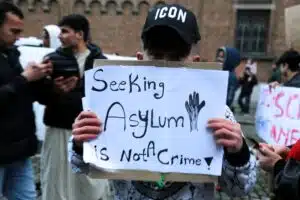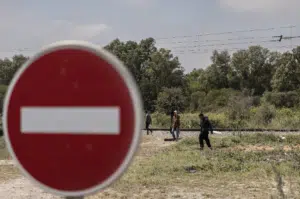Brussels – Now the legislative process has finally closed, all that is missing is the signature of the co-legislators of the EU Parliament and Council and publication in the Official Journal. The Migration and Asylum Pact is ready to become law throughout the Union, and within two years – in June 2026 – all its dossiers that comprise it will come into force. After the imposed approval by MEPs in the plenary session on April 10, the 27 EU governments gave the green light today (May 14) written procedure to a very complex migration and asylum legislation, which counts 13 dossiers in the reform sought by the von der Leyen Commission and agreed with extreme effort over the past four years.
With the legislative process concluded today and the final formal steps to be completed in the coming weeks, the EU institutions and the 27 capitals are already worrying about the implementation of all dossiers (but also about possible plans to outsource migration management outside EU borders, along the model of the Italy-Albania agreement). As the Commissioner for Home Affairs, Ylva Johansson, announced two weeks ago, “In June, the Commission will present the joint implementation plan. We have 10 building blocks. We will also create templates to support member states.” After that – according to a working paper from the EU Council General Secretariat obtained by Eunews – in July, the Resettlement Regulation will be implemented, while in September, the Implementing Act is expected to create adequate capacity to handle the future needs of the Twenty-seven.
The deadline for submission of national implementation plans is January 2025, “but I have proposed that drafts be submitted as early as November so that they can be discussed and prepared with sufficient support,” Commissioner Johansson disclosed. Finally, the national contingency plans must also be submitted by April 2025, and national strategies by June/July, with a deadline of June 2026 to implement all dossiers of the Migration and Asylum Pact. In all likelihood, Ireland (which, along with Denmark, has an opt-out clause on Home Affairs, i.e., a non-participation option) will also fully participate in this process after the decision on opt-in by the Dublin government.
The basis of the Migration and Asylum Pact
The new Migration and Asylum Pact system is based on the relationship between solidarity and responsibility in managing migrants among the 27 Member States. The first concept permeates the Regulation for the Management of Asylum and Migration (RAMM), which in no way overrides the cardinal principle of the 2013 Dublin Regulation, namely that the task of examining the asylum claim of a person who enters EU territory irregularly lies with the country of first arrival. Countries like Italy, Greece, Malta, Cyprus, and Spain will be responsible for applications. Other member states that want to ‘Dublin’ (i.e., extradite) these migrants – including minors and those applying for reunification with siblings -will have to send a notification, no longer a reciprocal due process request, with the agreement of the country of first arrival as is the case today. After the Regulation enters into force – 24 months after its publication in the EU Official Journal – the now famous mandatory solidarity mechanism for all Twenty-Seven (based on GDP and population) will kick in, equalizing the three forms of solidarity: relocations of migrants, financial contributions or support to third countries. Contributions to member countries can go to reception systems and to fund fixed and mobile border facilities through the Border and Visa Management Instrument (BMVI) and the Asylum, Migration and Integration Fund (AMIF). There will be no mandatory relocation for migrants disembarked after search and rescue operations at sea, and for those under the RAMM procedure, there is no legal representation, only counseling.
 The concept of accountability mostly relates to the Asylum Procedures Regulation (APR) and increases only those provided for countries of first entry. It will apply automatically in case of risk for security threat – including unaccompanied minors – of “deception of authorities,” or if the migrant comes from a country with a recognition rate of less than 20 percent. Border procedures will provide de facto detention, with no exemptions for families with children under 12, nor legal representation, nor a stay for appeals against most decisions (the exception is for inadmissibility of those based on the concept of “safe third country” and for unaccompanied minors). The “Safe Third Country” concept is crucial to this Regulation, with EU and national lists provided to justify and expedite rapid returns out of the Union, unless there are links between the person and the state from where they come that preclude their safety. New accountability obligations include completing the examination of an asylum application through the border procedure within six months(Apr), but also extending the period of responsibility for handling applications for 20 months and maintaining at 12 months that for search and rescue operations at sea (RAMM). The annual ceiling for border procedures is 30,000 people, based on a formula that takes into account the number of irregular border crossings and the number of expulsions in the previous three years.
The concept of accountability mostly relates to the Asylum Procedures Regulation (APR) and increases only those provided for countries of first entry. It will apply automatically in case of risk for security threat – including unaccompanied minors – of “deception of authorities,” or if the migrant comes from a country with a recognition rate of less than 20 percent. Border procedures will provide de facto detention, with no exemptions for families with children under 12, nor legal representation, nor a stay for appeals against most decisions (the exception is for inadmissibility of those based on the concept of “safe third country” and for unaccompanied minors). The “Safe Third Country” concept is crucial to this Regulation, with EU and national lists provided to justify and expedite rapid returns out of the Union, unless there are links between the person and the state from where they come that preclude their safety. New accountability obligations include completing the examination of an asylum application through the border procedure within six months(Apr), but also extending the period of responsibility for handling applications for 20 months and maintaining at 12 months that for search and rescue operations at sea (RAMM). The annual ceiling for border procedures is 30,000 people, based on a formula that takes into account the number of irregular border crossings and the number of expulsions in the previous three years.
What happens when migrant people arrive
Once migrants arrive at the Union’s borders, the Regulation on Screening of the Migration and Asylum Pact will provide a seven-day detention procedure to divide the regular (Ramm) or expedited (Apr) procedures to process their asylum claims. Since the so-called ‘fiction of non-entry’ has remained – that is, that anyone who is screened in a special center will not be considered legally on the territory of the member state and, therefore, of the EU – migrants will de facto be detained as they will have to remain at the disposal of authorities without the possibility of entering national soil. Some guarantees include the possibility for applicants to have access to a copy of the screening form and to preserve the “relevant rules on detention” set out in the 2008 Return Directive (the revision contained in the Migration and Asylum Pact is the only dossier that is certain to fail). But the monitoring mechanism – which does not necessarily include NGOs but can at the discretion of states- does not apply to border surveillance activities (with normalization of racial profiling), and, if the state recognizes a security threat, it will be able to grant national authorities direct access to all data on the person in all databases.

Regarding databases, according to the Eurodac Regulation, all migrants receiving temporary protection as of the age of six will have to accept the collection of their biometric data, even though under the General Data Protection Regulation (GDPR), processing is lawful only if the minor is at least 16 years old. Included in the expansion of data access for national authorities is the collection of photographic data of faces, effectively giving the green light to mass surveillance of migrants arriving on EU soil. Security alerts will be entered into the Eurodac database during the screening process, and border procedures will include a range of new categories – such as irregular border crossing – also through the revision of the Entry and Exit System Review Regulation.
What happens in a crisis
One of the most controversial items in the Migration and Asylum Pact is the Regulation for Crises, Instrumentality and Force Majeure, which deals with times when there is an exceptional or unexpected “mass arrival of people,” including following disembarkation after a search and rescue operation at sea. The Council negotiating position passed, which led to the inclusion of instrumentality (a Regulation that was initially a stand-alone and on which Parliament had not given the green light) in crises and force majeure in cases where “a hostile third country or non-state actor encourages or facilitates the movement of third-country nationals and stateless persons” towards the EU external borders “with the aim of destabilizing the Union or a Member State” by putting “the essential functions of a Member State at risk.” NGOs are excluded from this definition, but only if they can demonstrate that their actions (at sea and otherwise) do not aim to destabilize, with clear risks of repercussions for the criminalization of solidarity.

There are no compulsory relocations of migrants among member countries in crises, but the same three modes of solidarity as in the RAMM Regulation (relocations, financial contributions, or support to third countries) will apply. Instead, some scenarios will trigger derogations to the overall migration and asylum management system: the recognition rate threshold for which people can be admitted to border procedures (under the Apr Regulation at 20 percent) will be 50 percent in force majeure, 60/70 percent in crises, and 100 percent in instrumentality situations. Again, from the border procedures – the duration of which can be extended by an additional six weeks (compared to the nine months in April) – families with children under 12 are not excluded.
English version by the Translation Service of Withub









